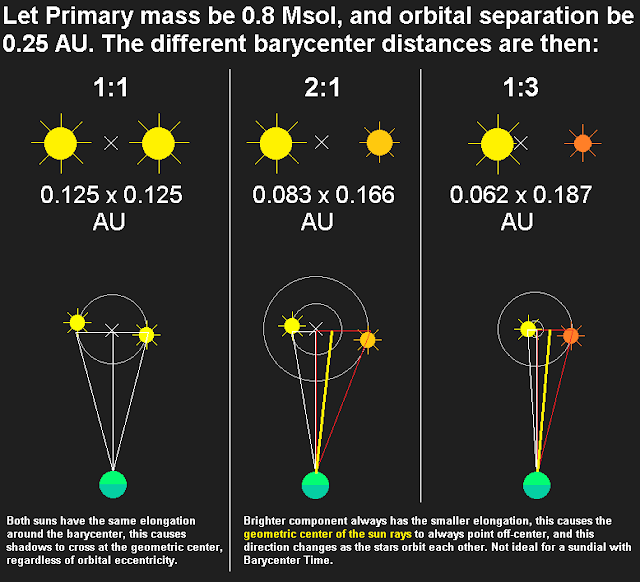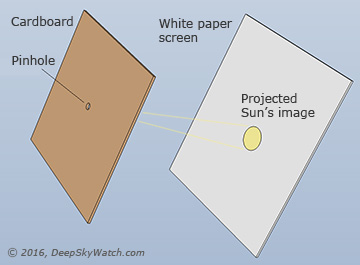Fellas over the northern hemisphere might already be familiarized by the sundial design above, formed by a disk or dial plate, with a triangular gnomon on top of it. None of the shapes here are of arbitrary dimensions, the inclination angle of the gnonmon has to match your Latitude (North/South coordinate), and the size of the gnomon in relation to the plate will determine wether the instrument can only tell hours or include the seasons/month markings. For the northern hemisphere inhabitants, one can eyeball the inclination of the gnomon by pointing to Polaris, the North Star, whereas southern people have to use known landmarks and constellations to get a sense of where to point it.
If you look at my design, you will notice a straight line, and two opposing hyperbolae, the straight line is called the Line of Equinoxes, it is where the shadow of the gnonomon falls during the Autumn and Vernal equinox days (Equinox or Equinoctis meaning "equal nights") - the two opposing hyperbolae are the Solstice lines, where the shadow falls during the summer and winter soltices respectively, by marking intermediary hyperbolae one can mark the passsages of months and weeks through the solar cycle.

Because of the Earth's tilt, one can draft a simple grid like the one I did by constructing a spherical grid marked 23.5° north and south of the equator, then putting a light source at its center, then tilting said spherical grid to the user's latitude - the resulting projection onto a sheet of paper will be your markings, and the distance from the paper to the center of the sphere is the same from the plate to your gnomon's tip, which is what you can see I rendered in the 3D software, then printed.
Without a 3D grid (physical or virtual), it takes a lot of math to traditionally work out the specific lines you'll need for you sundial, that's why the ancients often cut the middle-man and just projected their sundials onto convex hemispheres and rings!
There is a whole bunch of other types of sundials each specific to what their projectionists wanted to be told by the sun as well, but do any of those work for a world with two suns?THE SETTING
The system's stats I will be using thoughout this post
First of all, a quick googling of "Binary Star Sundial" retrieves not a lot of material, if someone has ever worked on anything like that, they didn't publish it on the internet, there are a couple posts on stackexchange and reddit dating back to 2016 but no solutions, most of them assume you can get away with a normal sundial since the shadows created onto a circumbinary planet would mostly be off by about 10° maximum - but this would only work as an approximation, depending on the specifics of the system, this would mean the clock could be offset by about 1h of the actual time (assuming the planet has 24h day/night cycle).
So before tackling the problem as a whole, let's see what changes from the traditional Terran sundial, so we can better know what challenges lie ahead:
DIFFERENCES BETWEEN SOLAR AND BISOLAR CLOCKS
1. MOVING SUNS
In the traditional solar clock, one can assume an inertial reference point, that could be either the static Earth with the Sun moving around it, or the static Sun-Earth system, with the Earth rotating around its axis.
On a bisolar clock, we have to consider not only either of those scenarios, but also that the suns are not static in the sky, they revolve around a common center of mass. Which means that for either scenario, the suns would always move significantly on a day to day basis - what would in itself, create a solar subcycle our natives to work with.
2. MISALIGNED ECLIPTIC
On Earth, the Ecliptic plane is the apparent path of the Sun across the sky throughout the year, it is pretty easy to follow through and it is what defines the constellations of the zodiac. On a circumbinary system however, one could either define the ecliptic as the planet's orbital plane, or the star's own orbital plane, in either case, both stars would constantly fall above and below the ecliptic as they orbit each other. Which means that the difference in orbital inclination between the stars and observer planet would change throughout the year as well. Anyone familiar with tracking the movements of Mercury and Venus in the sky will known how crazy the paths can look.

Because all of those movements are specific to the times and cycles at play, I will outline my process with an example so you can work out your own models of bisolar clocks. Since we cannot experience such a place, I will be using 3D software to simulate what it should look like based on the model stats given in my sketch.
UNDERSTANDING THE SKY
To keep things simple, I will work with geocentric coordinates, swapped the Sun in the solar system by a pair of twin stars with 80% of the mass, just so the brightness matches just the same on our planet, which had its tilt reduced to 20°. The star's also orbit each other at an angle of 5° from the planet's orbit.
Although for an external observer, the twin suns orbit each other every 36.1 days, the planet which is also orbiting the stars do not perceive this as being 36 Earth-days, we need to calculate the synodic period of the stars by using:
Which works out to be 41.25 Earth-days, or 990 hours, now we can use this information to set up the planet's rotation into some neat value that's easier to work with.
I will set the planet's rotational period to about 36 hours, this gives us a simple 10° per hour rotation, it approaches the solar subcycle to roughly 27.5 sidereal days (similar to a lunar month) - and makes the year about 192½ days. Meaning our stars move 13.1° over the course of a day, and half as much during daytime.
corrected suns declination at +0.624°
Usually, the planet's tropics would be located at latitudes 20° North and South of the Equator, but because the suns can gain about 0.62° of declination along their orbit, we can say that the tropics are found between 19° and 21° from the equator. This means that depending on the suns-planet alignment, the extra declination can come during solar opposition (suns seem aligned) or during maximum elongation (suns seem further apart).
The maximum elongation or separation between the suns in the sky would be about 14.5°, and this gives us another interesting alternative to measure the solar day, Mean Solar Time, which is measured from the barycenter, considered static while the suns orbit around it.
Further refinements put the sidereal day at 35h52m33s for a perfect 36 hour solar day
Let's also start our year in a point in the orbit when the suns seem further apart.
DESIGNING THE HOROLOGIUM BISOLARII
PRELIMINAR EXPERIMENT
An anallematic sundial consists of a vertical gnonom which marks the time throughout the day, but also tracks the months through the solar anallema by the length of the gnomon's shadow.
On Bisolaria, such an anallematic clock would produce two shadows which dance with twice the speed of the suns orbital period.
Each square is 10cm wide for scale, and the gnomon has 10cm from the base to the center of the sphere, the star light was tinted yellow and blue to differentiate, each time they switch sides corresponds to half a solar subcycle, and the whole animation takes place over two years (~385 sidereal days) on this planet, Bisolaria.
Each frame in the animation is taken at exact mean solar noon - if we picked a star to count solar days, then the frame of reference would wobble back&forth across all the four cardinal directions as that sun moves across the sky throughout the year, undesirable, which is why we count from the barycenter. Here we can also see the effects of the star's orbital inclination, at times a shadow appears longer than the other by a noticeable amount.
I bet we can use that tilt in the stellar orbital plane and the fact we are working with two shadows to come up with a creative horizontal anallematic clock and calendar. Why not double down with two gnomons then? My initial idea is to use two longer gnomons spaced in such a way that their shadows cross most of the time, the line at which they cross would determine the time of the year, while the point at which they cross would make up for the current hour of the day.
LOOKING AT THE SKY
So throughout the years, we would see the suns eclipse each other only during the planet's passage through the nodal line, where the sun plane crosses the ecliptic plane. We would also see the sun plane appear to tilt north or south as we cross the south and north pointing sides of the orbit, which by itself would be a good teller of seasons.
But we also have to consider the effects of the planet's orbital eccentricity, because the planet moves faster around the suns when it's closer than when it is farther - this causes the mean solar time to go faster and slower than the planet's true rotation period by a few minutes, which is what the Equation of Time is about. I'm not mentally stable nor know math enough to digest the needed equations so I could explain them better, but I've found a couple tools online that will be useful in generating the data require to produce a clock for a fictional world:
While the Analemma Calculator is pretty straightforward with single-sun systems, we'd need more work for the paths of the two or more suns we include. Below is a generalized version of the SageCell code, pointing where you need to input your data - if you're not familiar with Earth's parameters.


































